How Did This Software Engineer Climb Everest, Run a Marathon & Work Full-Time — All at Once?
“I wanted to take Tripura higher – literally and metaphorically.”
When most people say they’re balancing work and fitness, they usually mean a jog after work or squeezing in a yoga session before a client call. But for 30-year-old Aritra Roy, a software engineer with Tata Consultancy Services, Bengaluru, the word “balance” meant something far more ambitious: cycling from Agartala to Nepal, scaling Mount Everest, and finishing off with the world’s highest-altitude marathon, all while working a corporate job.
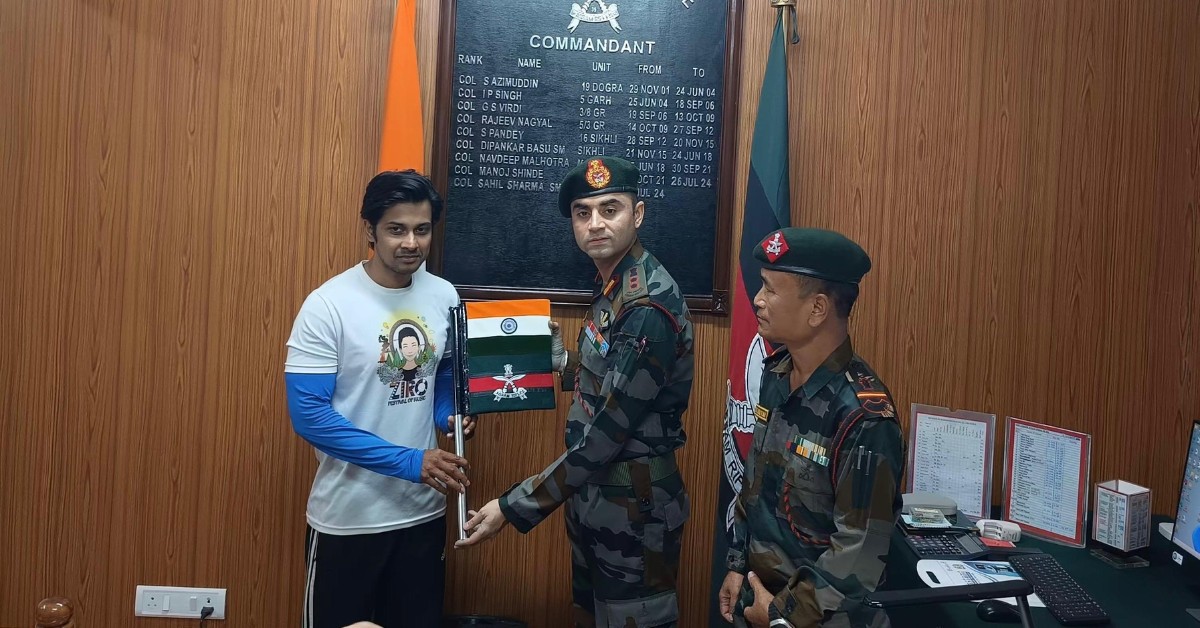 Before his expedition, Aritra received the Indian flag from the Assam Rifles to carry to the top of the world.
Before his expedition, Aritra received the Indian flag from the Assam Rifles to carry to the top of the world.
In May 2024, Aritra became the first person from Tripura to summit Mount Everest, completing a self-conceived “triathlon to the top”; a feat that fused his passion for endurance sports, sustainability, and his deep-rooted pride in representing the Northeast.
In conversation with The Better India, he shares that his story isn’t of a full-time athlete or a sponsored adventurer. It’s about a regular middle-class techie who turned his 9-to-5 job into a stepping stone rather than an obstacle. He didn’t quit his job. He didn’t get big funding. But he did get a vision and the sheer will to follow through.
Growing up in Agartala, Aritra never thought of becoming a mountaineer. “Adventure sports weren’t even a thing in Tripura. We didn’t have exposure or access,” he shares. But what he did have was an innate drive for physical activity. Running, cycling, swimming, he embraced them all as part of daily life, especially post-2020 when the COVID-19 waves spurred him into long-distance training.
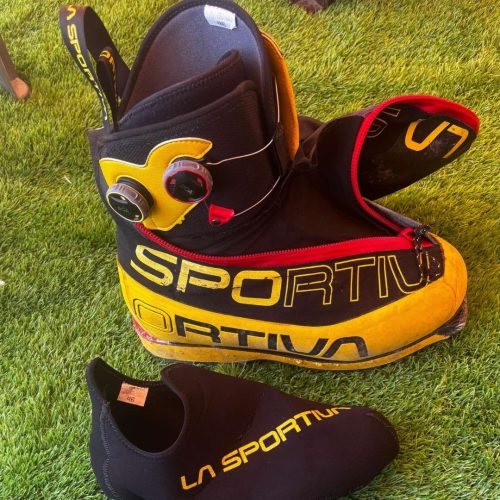 For the climb, Aritra invested in specialised high-altitude boots to endure extreme Himalayan conditions.
For the climb, Aritra invested in specialised high-altitude boots to endure extreme Himalayan conditions.
“I was regularly participating in marathons, open-water swimming events, triathlons. Somewhere along the way, I got fascinated by the idea of human endurance,” he tells The Better India.
The seed for Everest, though, was planted during a random scroll on the internet. “I came across a Swedish athlete who cycled all the way to Nepal, climbed Everest, and then cycled back. That image just stayed with me. I thought if he can do it, why not someone from India? Why not someone from Tripura?”
That question slowly transformed into a mission. Not only would he climb Everest, but he’d also cycle to Nepal and finish off with the Tenzing-Hillary Everest Marathon held every year on May 29, commemorating the first successful summit by Sir Edmund Hillary and Tenzing Norgay in 1953.
“I wanted the whole journey to be land-based and low-carbon. Adventure doesn’t have to leave a large footprint,” Aritra adds.
On the wheels for 21 days, covering 1,200 km
On 16 March 2024, Aritra took his first pedal stroke from Agartala, setting out for Nepal on a cycle loaded with basic supplies. The ride took 21 days, of which 14 were active cycling days, covering approximately 1,200 kilometres.
“I cycled around 80 to 100 kilometres a day and took rest days in between. I always started early in the morning and never cycled after sundown. Safety was crucial,” he says.
 Aritra cycled nearly 1,200 km from Agartala to Nepal as part of his self-designed triathlon challenge.
Aritra cycled nearly 1,200 km from Agartala to Nepal as part of his self-designed triathlon challenge.
The route wasn’t easy. From scorching heat to mechanical failures and unpredictable roads, he had to stay self-reliant throughout. “There were stretches where I wouldn’t see a decent eatery or repair shop for hours. But somehow, I didn’t feel lonely. I was doing this for a reason.”
That reason, for Aritra, was always bigger than just a personal record. “Tripura is never in the conversation when it comes to mountaineering or adventure sports. I wanted to change that. I wanted to inspire young people from the Northeast and show that even if you’re working a corporate job, you can dream big.”
Fellow cyclist and friend Debabrata Majumdar, who accompanied Aritra on part of the expedition, recalls a powerful moment from day one. “We were faced with high ascents from the two long mountain ranges of Tripura – Baramura and Atharamura. It was very hot and humid, and most of us were not able to ride due to dehydration. Aritra managed the group properly, planning the ride interval, getting hydration from nearby villages, and carefully choosing the halt location. He kept encouraging the entire team and made us rest when the heat became unbearable. He is a true leader.”
Achieving the feat of getting onto the highest peak
After reaching Nepal, Aritra rested for a few days before beginning the Everest Base Camp trek and acclimatisation. On 29 April 2024, he began the final push.
The Everest climb is notoriously gruelling with dangerous icefalls, thin air, and sub-zero nights. “There were moments during the summit push when I thought, ‘Why am I doing this?’ But then I’d remember all the people back home cheering for me, the sacrifices I’d made, and the responsibility I felt representing Tripura.”
 The Khumbu Icefall section was one of the toughest challenges Aritra faced during the climb.
The Khumbu Icefall section was one of the toughest challenges Aritra faced during the climb.
At around 4 AM on 21 May 2024, Aritra reached the top of the world.
“It was pitch dark when I summited. The sun hadn’t risen yet, and everything around me was silent just my breath, my heartbeat, and the crunch of snow. I took a small flag of India out of my pocket, held it up, and broke down, recalls the mountaineer while speaking to The Better India.
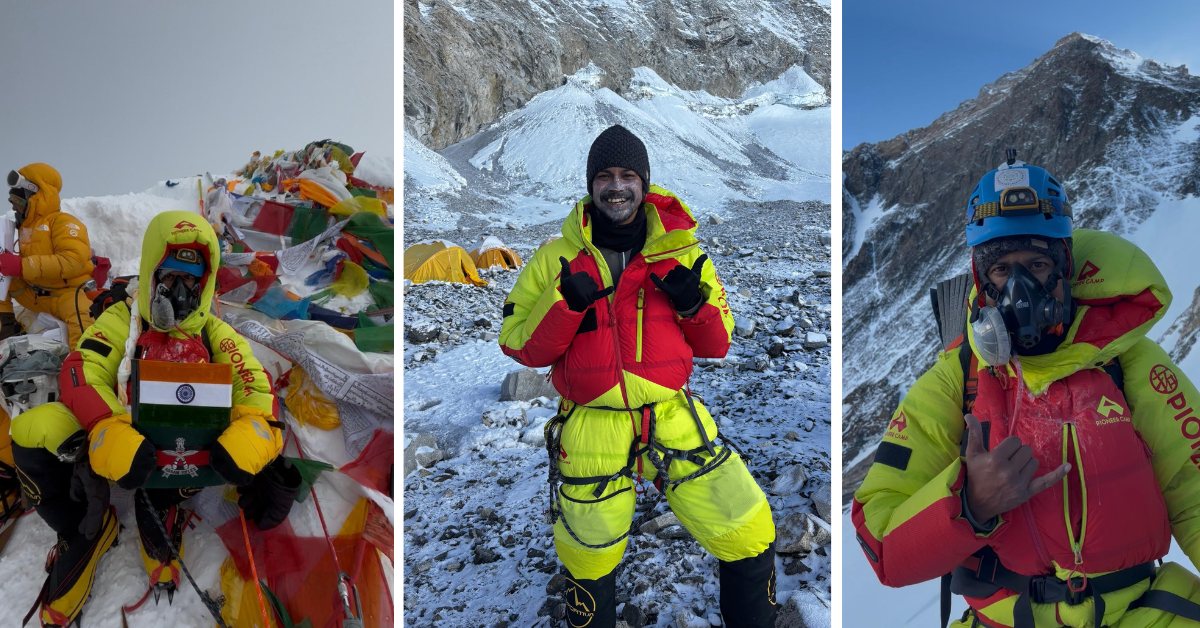 At 8,848 m, Aritra fulfilled his dream and became the first person from Tripura to summit Mount Everest.
At 8,848 m, Aritra fulfilled his dream and became the first person from Tripura to summit Mount Everest.
Debabrata, who witnessed Aritra across all three legs, cycling, climbing, and running, shares, “What truly surprised me about Aritra was his emotional stability under intense pressure. Most people either rush or freeze when things go sideways, but Aritra seems to enter a zone of total clarity. That calm confidence held the team together more than once.”
He adds, “For an expedition like Everest, the most important part is preparation. And I’ll give full marks to Aritra for how meticulously he prepared. Whether it was the Ladakh Marathon or cycling to Khardung La, he trained with purpose, patience, and an obsession for detail. His success wasn’t luck, it was inevitable.”
Completing a marathon at 17,500 ft
Most climbers would consider the Everest summit the final goal. But Aritra had one more feat left , the Everest Marathon, which starts at base camp and descends over 42.2 km through rugged Himalayan terrain.
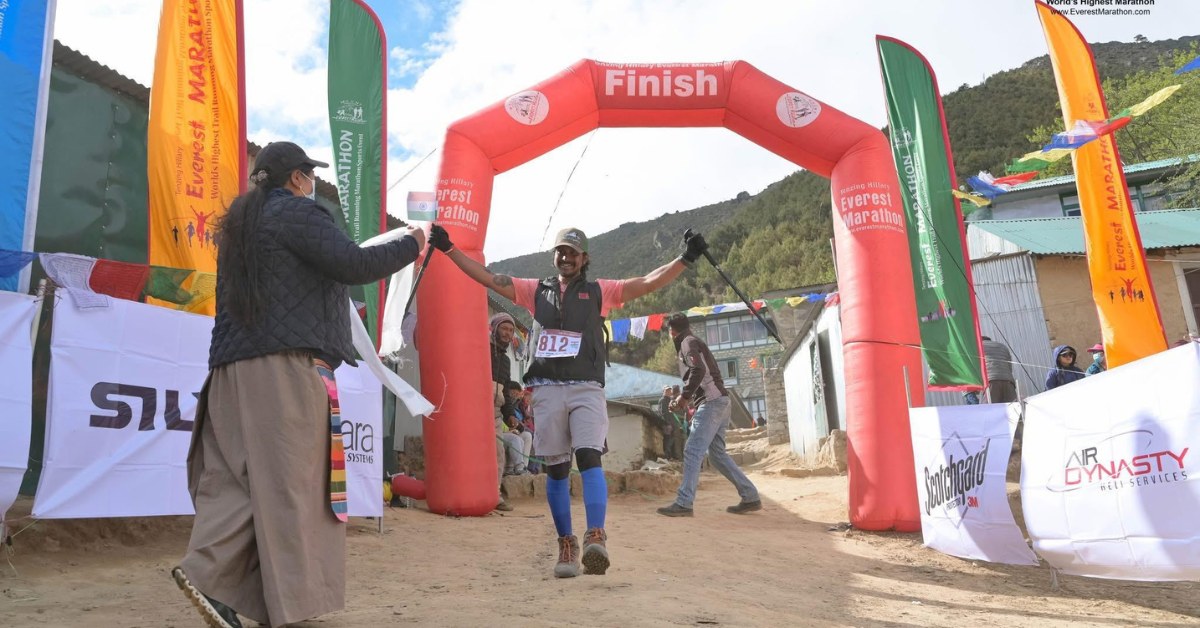 Just days after summiting Everest, Aritra ran the 42-km Tenzing-Hillary Everest Marathon at 17,500 ft.
Just days after summiting Everest, Aritra ran the 42-km Tenzing-Hillary Everest Marathon at 17,500 ft.
“Running at that altitude, right after the summit, was the hardest thing I’ve ever done,” he laughs. “My body was exhausted, my muscles sore, but I was mentally locked in. I just had to finish.”
Debabrata puts it in perspective: “A full triathlon usually happens over a few hours on a marked route with crew support. But Aritra’s triathlon spanned two and a half months and 1,600+ km, and much of it was self-supported. The mental resilience that is required is beyond anything most people can imagine.”
“If I had to describe Aritra’s expedition and conquering Everest spirit in a metaphor, I’d say: He was like a flame that learned to burn brighter in the thin air. Everest doesn’t just test strength—it strips you down to your core. But Aritra didn’t just endure—he thrived.”
The woman behind the mountain man
While Aritra’s body was climbing Everest, his emotional anchor stayed grounded in Bengaluru – his wife, Ashirbani.
From budgeting to moral support, Ashirbani played a crucial role in keeping Aritra’s dream alive. “We were not financially well-off. We had to take a personal loan for this expedition. Half the funds came through savings, and the rest through credit,” she tells The Better India.
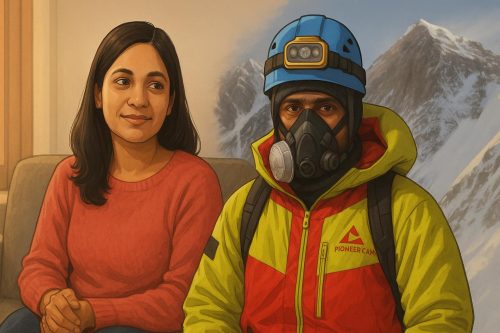 While Aritra braved Everest, his wife Ashirbani managed finances, logistics, and morale from Bengaluru. (AI-generated image)
While Aritra braved Everest, his wife Ashirbani managed finances, logistics, and morale from Bengaluru. (AI-generated image)
Initially worried about his safety and the financial strain, Ashirbani says, “At one point, I asked him, are you sure you want to do this while working full-time? But his determination convinced me. He was doing it not just for himself but for an entire region.”
She also handled logistics and kept his morale high during difficult moments. “I was tracking his GPS location every single day. The few times he could call from the mountains, I just reminded him how proud we all were. That was enough.”
Balancing the keyboard and the Karakoram
What makes Aritra’s story stand out is how ordinary his life looks from the outside. No sabbaticals. No elite athlete funding. Just a man logging into work each day and logging miles in the morning and evening.
He trained for Everest while managing client calls, coding projects, and the occasional business trip. “My company was supportive, but there were no special favours. I used my leaves wisely and planned my training around my work hours,” he explains.
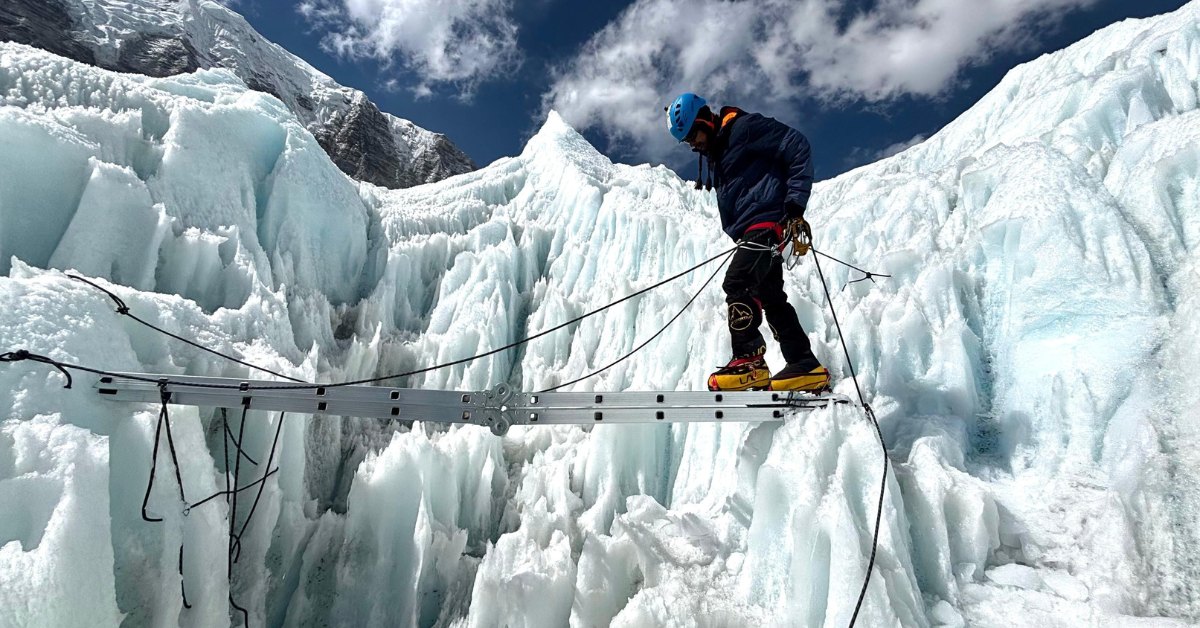 At Base Camp, Aritra spent days acclimatising and training for the technical climb ahead.
At Base Camp, Aritra spent days acclimatising and training for the technical climb ahead.
Early morning cycling, weekend swims, and late-night gear research became the norm. “It was exhausting, but it taught me how to make time for my dreams instead of waiting for the right time.”
He even used his journey to promote sustainable travel. “I didn’t fly to Kathmandu. I didn’t take a chopper to base camp. Every kilometre, I tried to cover on foot or wheels. I wanted to show that adventure can be intentional.”
Inspiring the Northeast and beyond
Since his return, Aritra has been flooded with messages from aspiring mountaineers, athletes, and young people across India especially the Northeast.
“Many people from Tripura told me they didn’t know someone from their state could climb Everest. That broke my heart but also made me feel responsible. We need more stories from our region,” he says.
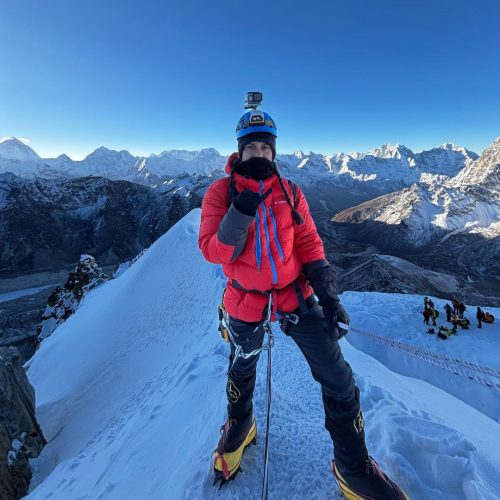 Before Everest, Aritra trained by summiting Lobuche East (6,119 m) to prepare for the extreme altitude.
Before Everest, Aritra trained by summiting Lobuche East (6,119 m) to prepare for the extreme altitude.
He plans to conduct workshops in schools and colleges in Tripura to promote fitness, endurance sports, and mental strength. “We need to invest in young people’s confidence. They have the fire. They just need someone to show them the path.”
As Arjun beautifully summarizes: “If I had to describe Aritra’s expedition in a metaphor, I’d say he was like a flame that learned to burn brighter in the thin air. Everest strips you to your core. Most flicker out. But Aritra thrived. The higher the stakes, the stronger his resolve.”
A story that is just starting
While most would retire from adventure after such a feat, Aritra is already dreaming up his next challenge, something even more accessible, inclusive, and sustainable.
“I don’t want this to be about just me. I want to build a community of endurance athletes from the Northeast, from regular working backgrounds. You don’t need a million followers or big sponsors. You just need to start.”
Back in Bengaluru, between stand-up meetings and sprint planning sessions, Aritra is just another guy at his desk. But in his heart, he’s still on the trail, carrying the flag of India to new heights.
As Ashirbani puts it, “He might be a software engineer by profession, but in spirit, he’s an explorer. And this is just the beginning.”
News